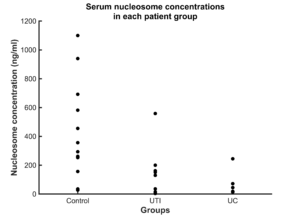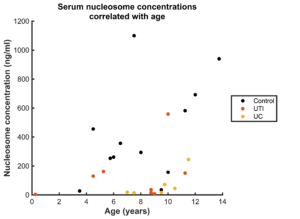Evaluating serum nucleosomes in dogs with urothelial carcinoma and urinary tract infections
15 July 2025
Dr Ollie Bardsley carried out a BSAVA PetSavers-funded student research project under the guidance of Professor Tim Williams at the University of Cambridge, which investigated the use of serum nucleosomes as a biomarker for urothelial carcinoma in dogs. He describes his work here.
I think that having a background in research prior to starting this study was beneficial, as I felt well equipped to critically evaluate research papers, focus my investigative approach and present my findings. However, transitioning from mathematical modelling to a lab-based project was a struggle! I am extremely grateful to Professor Tim Williams, who offered to work with me on this study, and to the hardworking team in the clinical pathology department who helped me to overcome obstacles performing the ELISA assay. This project has inspired me to continue my research during my veterinary practice, and I hope to revisit this field to further contribute to the literature on veterinary diagnostics. In addition, I feel much better equipped working in a laboratory, which is particularly important as I hope to continue my studies further with postgraduate qualifications soon!
INTRODUCTION
Urothelial carcinoma (UC) is the most common neoplasm of the canine lower urinary tract. UC is a problematic neoplasm as it can lead to urinary obstruction, recurrent urinary tract infections (UTIs) and secondary metastatic disease. UC is typically suspected on ultrasonographic changes; however, definitive diagnosis requires collection of cells/tissue by suction biopsy, which necessitates general anaesthesia and may require referral to a specialist centre. This means that there is a demand for non-invasive, sensitive and specific tests which can be performed by general practitioners.
Recent work has demonstrated that nucleosomes – small fragments of chromosomes released into the extracellular space during cell death or inflammation – may be a useful biomarker for this purpose. Recently, a commercially-available nucleosome ELISA has been validated for use in dogs, and further studies have demonstrated that nucleosome concentrations are increased in dogs with lymphoma and haemangiosarcoma1-3.
However, very little data is available to show what happens to circulating nucleosome concentrations in dogs with urothelial carcinoma. Therefore, I worked with Professor Tim Williams to retrospectively evaluate nucleosome concentrations using the commercially available ELISA test on patients with UC, UTIs and those in a control group, in spring 2024.
What did we find?
Forty dogs previously seen at the Queen’s Veterinary School Hospital (QVSH) were included in the study, of which 13 were in the UC group and 12 in the UTI group. Measurements of the test intra-assay variability in nucleosome concentrations for validation purposes was investigated on three separate days, and was low with a co-efficient of variation in optical densities of 14%. Inter-assay variability was investigated by measuring nucleosome concentrations in the same samples over multiple days, but was found to be unusually poor. This could be explained by a destruction of nucleosomes after these samples underwent a freeze-thaw cycle.
Interestingly, the serum nucleosome concentrations determined in the control group were significantly higher than those in the UTI group (median 262 ng/ml vs median <36.6 ng/ml, p = 0.044) and the UC group (<36.6 ng/ml, p = 0.005) (Figure 1). This disproved our hypothesis that UC and UTIs are associated with increases in serum nucleosome concentrations. These data are also contrary to literature suggesting neoplastic disease and inflammatory disease are associated with increases in serum nucleosome concentrations4. However, these findings may be the result of sample handling artefacts such as delayed time between sampling and serum separation and freezing.

Figure 1: Serum nucleosome concentrations in each of the patient groups.
No significant difference was found when comparing nucleosome concentrations between dogs of different sexes (p = 0.379), consistent with literature findings. Furthermore, a correlation between age and nucleosome concentration was not apparent (Figure 2), which is consistent with previous literature failing to identify a significant relationship between age and nucleosome concentration5-6.

Figure 2: Serum nucleosome concentrations correlated with age.
Unusually, 16/40 samples had serum nucleosome concentrations that were determined to be above the “high risk” reference interval provided by the test manufacturer for diagnosis of neoplastic disease (81 ng/ml). We hypothesise that this result is reflective of potentially suboptimal sample handling, but also the inclusion of unhealthy animals in our control group, due to the nature of our study only including patients which had been previously seen at a referral hospital.
The potential of a blood-based nucleosome assay for the detection of UC remains to be determined, and further studies measuring circulating nucleosome concentrations in EDTA plasma handled in the optimal way may help to elucidate this.
What does this mean for general practitioners?
Urine-based assays to detect BRAF mutations are used in general practice to raise a clinician’s index of suspicion for UC. While this assay is highly specific, its sensitivity is reported to be as low as 64%.7 By contrast, a blood-based nucleosome assay may have better sensitivity and specificity for UC. Such a test may support a veterinarian’s clinical suspicion of UC, and may prompt them to advise an ultrasound of the urinary tract for suction biopsy and definitive diagnosis. While our data fail to support serum nucleosomes as a biomarker for this purpose, further studies into other biomarkers may identify one which can be detected in the blood of dogs with UC with high sensitivity and specificity. A test such as this would enable the prompt diagnosis of UC, leading to patients receiving treatment more rapidly, prior to metastatic spread or significant urinary obstruction.
Why consider BSAVA PetSavers?
This study was only possible due to the kind support of BSAVA PetSavers funding. Without our PetSavers grant, we wouldn’t have been able to cover the cost of the ELISA kits and laboratory consumables, and wouldn’t have been able to share these interesting findings. I would encourage anybody inspired to research diagnostics in small animal medicine to explore PetSavers as a means of funding. PetSavers also enables veterinary students and vets to publish their findings and present them to the wider veterinary community at the annual BSAVA Congress. I personally look forward to presenting these findings at BSAVA Congress 2025 and I would strongly encourage anybody within the veterinary community with a passion for research to consider BSAVA PetSavers as a funding opportunity.
ABOUT THE AUTHOR
References
- Wilson-Robles, H., Miller, T., Jarvis, J., Terrell, J., Dewsbury, N., Kelly, T., Herzog, M., Bygott, T., Hardat, N., and Michel, G. (2020). Evaluation of nucleosome concentrations in healthy dogs and dogs with cancer. PLOS ONE 15, e0236228. https://doi.org/10.1371/journal.pone.0236228.
- Krogh, A.K.H., Lyngby, J.G., Bjørnvad, C.R., and Nielsen, L.N. (2021). Presence of nucleosomes in plasma and increased thrombin generation in dogs with acute and chronic gastroenteropathies. Research in Veterinary Science 135, 504–510. https://doi.org/10.1016/j.rvsc.2020.11.012.
- Wilson-Robles, H.M., Bygott, T., Kelly, T.K., Miller, T.M., Miller, P., Matsushita, M., Terrell, J., Bougoussa, M., and Butera, T. (2022). Evaluation of plasma nucleosome concentrations in dogs with a variety of common cancers and in healthy dogs. BMC Veterinary Research 18, 329. https://doi.org/10.1186/s12917-022-03429-8.
- Holdenrieder, S., Stieber, P., Bodenmüller, H., Busch, M., Fertig, G., Fürst, H., Schalhorn, A., Schmeller, N., Untch, M., and Seidel, D. (2001). Nucleosomes in serum of patients with benign and malignant diseases. Int J Cancer 95, 114–120. https://doi.org/10.1002/1097-0215(20010320)95:2<114::aid-ijc1020>3.0.co;2-q.
- Wilson-Robles, H., Miller, T., Jarvis, J., Terrell, J., Kelly, T.K., Bygott, T., and Bougoussa, M. (2021). Characterizing circulating nucleosomes in the plasma of dogs with hemangiosarcoma. BMC Veterinary Research 17, 231. https://doi.org/10.1186/s12917-021-02934-6.
- Dolan, C., Miller, T., Jill, J., Terrell, J., Kelly, T.K., Bygott, T., and Wilson-Robles, H. (2021). Characterizing circulating nucleosomes in the plasma of dogs with lymphoma. BMC Vet Res 17, 276. https://doi.org/10.1186/s12917-021-02991-x.
- Gedon, J., Kehl, A., Aupperle-Lellbach, H., von Bomhard, W., and Schmidt, J.M. (2022). BRAF mutation status and its prognostic significance in 79 canine urothelial carcinomas: A retrospective study (2006–2019). Veterinary and Comparative Oncology 20, 449–457. https://doi.org/10.1111/vco.12790.
Supporting more BSAVA PetSavers-funded research
Help us fund more clinically-relevant veterinary research into companion animal diseases by donating today at www.bsava.com/petsavers/donate or scanning the QR code:


